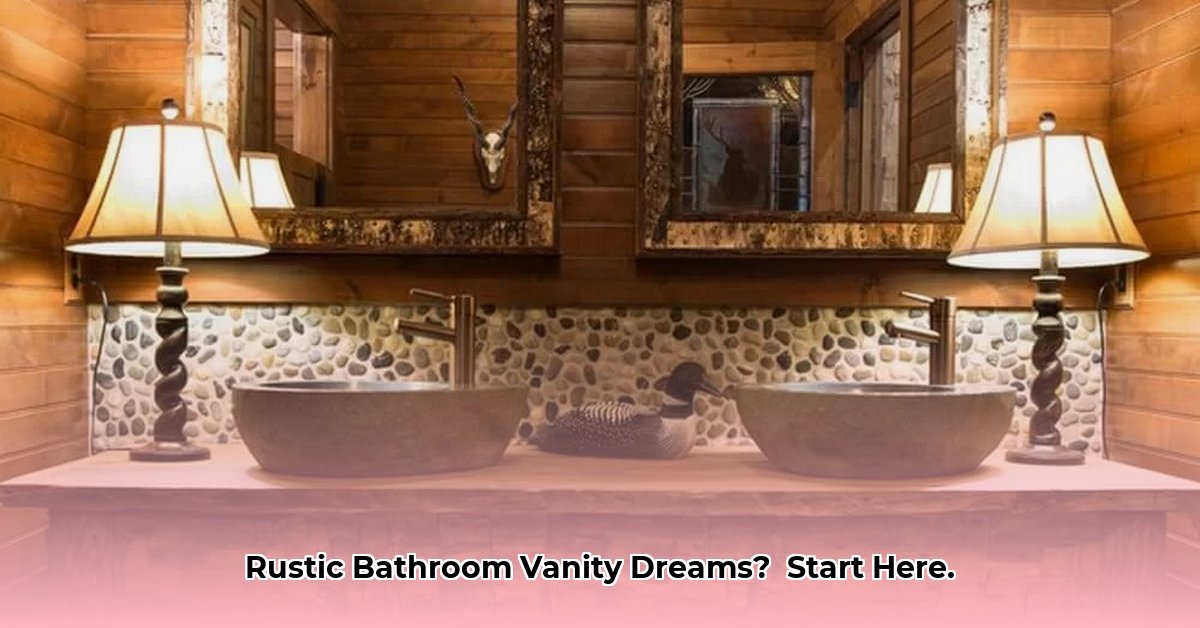Ready to transform your bathroom into a rustic sanctuary that exudes both beauty and enduring quality? Let’s move beyond generic, modern designs and delve into the world of rustic bathroom vanities! These are statement pieces that infuse warmth and personality into your space. This guide will empower you to navigate the selection process, whether you’re drawn to the eco-conscious appeal of reclaimed wood or the classic charm of new pine. We’ll explore diverse styles, customization possibilities, and essential considerations to ensure you make a well-informed decision. Prepare to craft a bathroom you’ll cherish, one that genuinely captures your individual style.
Rustic Bathroom Vanity Ideas: Design Your Dream Escape
Selecting a bathroom vanity transcends mere furniture acquisition; it’s about choosing a focal point that embodies your aesthetic and enhances your daily routine. A rustic bathroom vanity, distinguished by its fusion of natural materials and artisanal craftsmanship, can elevate your bathroom into a serene haven. However, navigating the expansive realm of rustic vanities can seem daunting. This guide simplifies the journey, assisting you in designing the ideal vanity for your space and budget.
The Great Material Debate: Reclaimed Wood vs. New Pine and the Quintessential Rustic Style
The essence of your rustic vanity lies in its material composition. Reclaimed wood and new pine stand out as two prominent choices, each presenting distinct advantages and disadvantages. How do you determine the best fit for your overarching bathroom design?
Reclaimed wood, often sourced from aged barns or industrial structures, boasts an unparalleled aesthetic. Each piece carries a narrative, with its knots, distinctive markings, and unique patina echoing tales of its past. This intrinsic character contributes to a rich, lived-in ambiance that’s difficult to replicate. Furthermore, it represents an environmentally responsible choice, repurposing aged wood and minimizing landfill contributions. However, this sustainable aspect often translates to a higher price point. Locating the precise piece you envision may necessitate some searching, as availability can fluctuate.
Conversely, new pine offers a more readily accessible and typically more economical option. Its consistent grain and uniform texture facilitate easier customization and a wider array of finishes. While it lacks the inherent history of reclaimed wood, new pine can be expertly distressed to emulate the appearance of aged wood, achieving a rustic feel without the premium cost. Ultimately, the decision hinges on your budget, desired aesthetic, and dedication to environmentally conscious practices.
| Feature | Reclaimed Wood | New Pine |
|---|---|---|
| Cost | Higher | Lower |
| Availability | Limited; sourcing may require extended search efforts | Readily available |
| Appearance | Unique character; distinctive knots, patinas, imperfections | Consistent grain; easily distressed to achieve a rustic aesthetic |
| Sustainability | Highly sustainable; repurposes existing material | Less sustainable; utilizes newly harvested materials |
| Durability | Highly durable with proper treatment | Durable with appropriate treatment and sealing |
Crafting Your Custom Vanity: Unlimited Possibilities and Optimal Storage Solutions
The allure of a rustic vanity resides in its remarkable adaptability. It transcends the notion of merely acquiring a pre-made piece; it involves designing a vanity that seamlessly integrates with your bathroom’s layout and reflects your unique style. What’s the most effective approach to customizing your vanity’s storage capabilities?
Contemplate these vital customization options:
- Size: Precisely measure your available space. A vanity that’s too large will overwhelm a compact bathroom, while one that’s too small will feel inadequate.
- Sink Type: Vessel sinks, drop-in sinks, and undermount sinks each present a distinct aesthetic and functional advantage.
- Storage: Carefully assess your storage requirements. Do you need ample drawers, open shelving, or a harmonious combination of both? Consider the types of items you intend to store – towels, toiletries, and so forth.
- Finish: Ranging from a light, weathered gray to a deep, rich brown, the finish significantly influences the overall ambiance. Explore a spectrum of stain colors and finishes to discover the perfect complement for your bathroom.
- Hardware: Knobs, pulls, and hinges all contribute to the overall style. Select hardware that enhances your chosen finish and stylistic preferences.
Conceptualize the customization process as a collaborative endeavor. Work closely with your chosen artisan or manufacturer, articulating your vision and allowing them to guide you through the array of possibilities. The outcome will be a vanity that’s uniquely yours – a true reflection of your taste and requirements.
Styles of Rustic Charm: Discovering Your Ideal Match and Design Inspirations
The term “rustic” encompasses a diverse spectrum of styles. To assist you in narrowing your choices, consider these prominent aesthetics:
- Farmhouse: This style evokes a sense of inviting warmth and unpretentious simplicity. Expect straightforward designs, distressed finishes, and often a touch of endearing imperfection. Common features include apron-front sinks and shaker-style doors.
- Industrial: This aesthetic embraces raw materials and a more minimalist approach. Anticipate clean lines, metal accents, and a prioritization of functionality. Exposed pipes and concrete countertops are often incorporated.
- Modern Rustic: This style harmoniously blends the best of both worlds, merging the clean lines and simplicity of modern design with the inherent warmth of rustic materials. Think sleek silhouettes combined with reclaimed wood accents.
Browse design publications, online resources, and platforms like Pinterest for inspiration. Compile a mood board to gather visuals that resonate with you, aiding in the refinement of your vision. Don’t hesitate to experiment with combining elements from various styles to cultivate a truly unique and personalized aesthetic.
Budgeting for Your Dream Vanity: Investing Judiciously and Making Informed Choices
Let’s address the financial aspect: cost. The price range for a rustic vanity can vary considerably, influenced by factors such as material selection, dimensions, extent of customization, and the level of craftsmanship involved. While a smaller vanity constructed from new pine may represent a more budget-conscious option, a larger, custom-designed vanity crafted from reclaimed wood will likely command a higher price point.
Bear in mind that your vanity constitutes an investment. It serves as a focal point in your bathroom that will likely remain there for years – even decades – to come. Weigh the initial expense against its enduring aesthetic value and structural integrity. Shop around, compare prices from multiple vendors, and don’t be hesitant to negotiate. Striking a balance between quality and affordability is paramount.
Actionable Steps: Selecting Your Perfect Rustic Vanity and Initiating the Process
What preliminary considerations should be addressed before embarking on your rustic vanity project?
For Consumers:
- Establish a realistic budget: Determine a practical budget before commencing your search.
- Accurately measure your space: Precise measurements are essential for selecting the appropriately sized vanity.
- Research materials and styles: Explore the various options and select those that best align with your style preferences and budgetary constraints.
- Identify a reputable supplier: Conduct thorough research and review customer feedback before committing to a purchase.
- Pose pertinent questions: Don’t hesitate to inquire about materials, construction methods, and warranty provisions.
- Visualize the final result: Employ design tools or create a mood board to aid in visualizing your ideal vanity.
For Manufacturers/Retailers:
- Emphasize craftsmanship: Invest in high-resolution photography and videography to effectively showcase your products.
- Offer customizable options: Tailor your offerings to accommodate a broad spectrum of customer preferences.
- Cultivate a robust online presence: Develop a user-friendly website featuring detailed product specifications and engaging visuals.
- Establish partnerships with designers and influencers: Collaborate with design professionals to broaden your reach and demonstrate your products’ versatility.
Your Rustic Bathroom Oasis Awaits: The Next Steps
Designing your dream rustic bathroom vanity is a rewarding endeavor. By carefully considering the factors outlined above – materials, customization, style, and budget – you’ll be well-prepared to create a stunning and functional centerpiece for your bathroom. Remember, it’s more than just a vanity; it’s the heart of your personal sanctuary. Embrace the process, and the result will be a space that provides joy and relaxation for years to come.
How to Choose Between Reclaimed Wood and Rustic Pine Bathroom Vanities: A Summary
Key Takeaways:
- Rustic bathroom vanities imbue spaces with unique character, seamlessly blending natural materials with timeless designs.
- Reclaimed wood offers sustainability and distinctiveness, while rustic pine provides affordability and consistent quality.
- Customization options encompass size, finish, sink type, and storage configurations.
- A diverse array of styles caters to various tastes, spanning from farmhouse to industrial to modern rustic.
- Consider your budget; handcrafted vanities typically command a premium price.
Material Matters: Reclaimed Wood vs. Rustic Pine and Determining Sustainability
Selecting the appropriate wood for your rustic bathroom vanity is paramount. How to Choose Between Reclaimed Wood and Rustic Pine Bathroom Vanities is a question many homeowners grapple with. Let’s evaluate the advantages and disadvantages: Is reclaimed wood genuinely more sustainable?
| Feature | Reclaimed Wood | Rustic Pine |
|---|---|---|
| Sustainability | Highly sustainable; repurposes existing wood resources. | Less sustainable compared to reclaimed wood; utilizes new growth. |
| Cost | Typically more expensive due to sourcing and processing. | Generally more affordable and readily available. |
| Aesthetic |
- Modern Kitchen Backsplash Ideas To Inspire Your Refresh - December 19, 2025
- Modern Backsplash Ideas: A Guide to Todays Kitchen Trends - December 18, 2025
- Ceramic Kitchen Wall Tiles: Style and Protection for Your Walls - December 17, 2025









